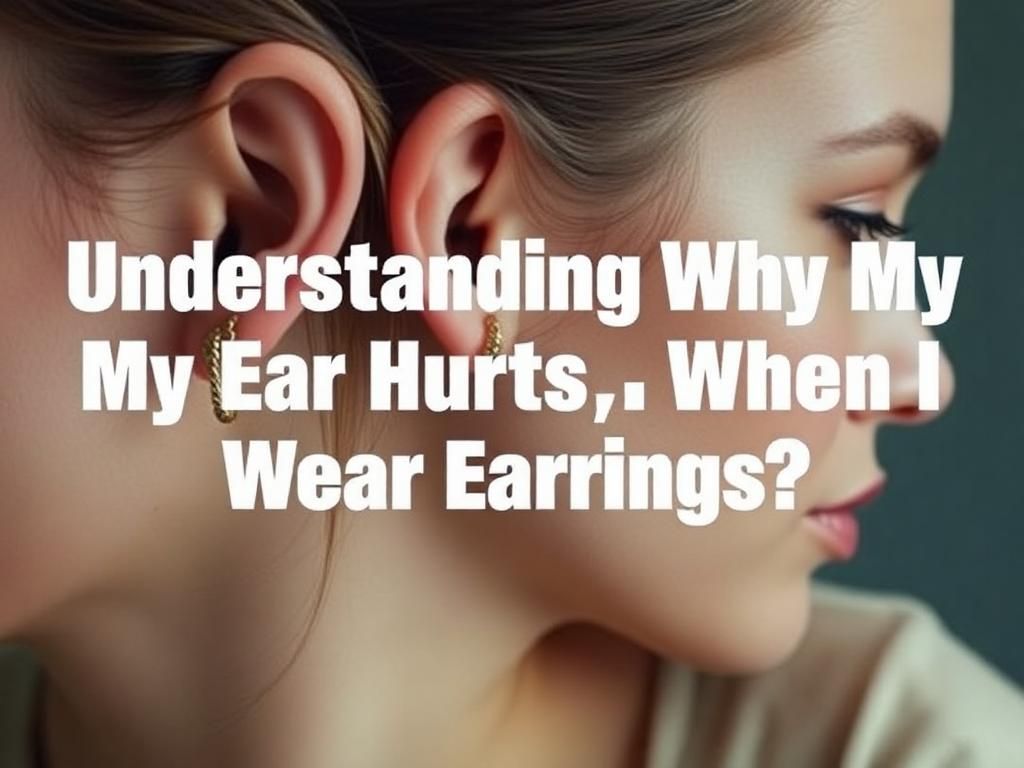Experiencing pain in your earlobes when wearing earrings is a common issue that many face, regardless of the occasion. Whether you’re dressing up for a party or adding a funky touch to your daily attire, the pleasure of adorning your ears with sparkling jewelry can quickly turn into discomfort or pain. Understanding why does my ear hole hurt when I wear earrings is vital, as it not only addresses your concern but also promotes better ear care practices.
Your ear health is essential, especially when engaging in activities involving piercings and wearing earrings. So, let’s delve into the intricate world of ear anatomy and explore the common causes of ear hole pain, symptoms to watch for, preventive measures, and more.
Understanding Ear Anatomy
Overview of the Ear Structure
The human ear comprises several parts that work together to facilitate hearing and balance. A brief overview includes:
– External Ear (Auricle): The visible part of the ear that enhances sound collection.
– Ear Canal: The passage that directs sound waves to the eardrum.
– Eardrum and Inner Ear: The eardrum vibrates in response to sound waves, sending signals to the inner ear for processing.
Parts of the Ear Involved in Piercing
When it comes to body piercings, understanding the biology of the ear can help clarify potential pain reasons:
– Cartilage vs. Lobe Piercing: Cartilage piercings are typically more painful than lobe piercings due to fewer blood vessels and greater nerve sensitivity.
– Blood Supply and Nerve Endings in the Ear: The ear is richly supplied with blood vessels and nerves, making any irritation or trauma noticeable.
Common Causes of Ear Hole Pain
Earrings Material Reaction
One of the leading causes of ear hole pain is an allergic reaction to the materials in your earrings. Many common metals can cause irritation, including:
– Nickel Allergy or Sensitivity: Nickel is a common irritant. If you have a nickel allergy, even slight exposure can trigger discomfort.
– Other Common Allergic Materials: Allergies can also arise from materials like gold, silver, or plastic.
Infections
Infections pose a significant risk when earrings are worn consistently.
– Symptoms of Ear Infections: Symptoms may include redness, swelling, and pus discharge.
– Bacterial vs. Fungal Infections: Ear infections can be bacterial or fungal, with both types potentially resulting in painful symptoms.
Irritation and Inflammation
Everyday activities can lead to irritation and inflammation of the pierced area.
– Skin Irritation from Friction: The constant movement of earrings can cause friction, leading to uncomfortable irritation.
– Swelling Due to Prolonged Wearing: Extended wear can cause swelling and tenderness around the piercing site.
Improper Jewelry Size or Weight
Using earrings that are too heavy or not appropriately sized can lead to significant discomfort.
– Too Heavy Earrings Causing Strain: Heavy earrings can pull on the lobe, causing pain or even tearing.
– Incorrect Gauge for the Piercing: Earrings with an inappropriate gauge can compress or irritate the piercing, leading to pain.
Poor Piercing Technique
The method used for piercing can have a lasting impact on your ear health.
– Importance of Professional Piercing: Professional piercers ensure that the procedure is done safely to minimize complications.
– Risks of Home Piercings and Improper Care: Improperly executed piercings can lead to infections, numerous complications, and persistent pain.
Skin Conditions
Various skin conditions can manifest in the ear area, contributing to pain.
– Dermatitis and Eczema around the Ear: Conditions like dermatitis can make the area around the earlobe sensitive.
– Other Skin Issues Affecting Ear Health: Individuals with pre-existing skin issues may find their ears also reacting negatively to jewelry.
Symptoms Accompanying Ear Hole Pain
Common Symptoms to Watch For
When experiencing ear hole pain, it is crucial to monitor additional symptoms that may highlight a more severe issue:
– Redness and Swelling: These can indicate irritation or infection.
– Unusual Discharge (Pus or Clear Fluid): Discharge is a red flag that should prompt further investigation.
– Increased Warmth Around the Piercing: Heat can signify inflammation or infection.
– Itching or Burning Sensation: These symptoms may point towards an allergic reaction.
When to Seek Medical Attention
Identifying Severe Symptoms
Knowing when to consult a professional can save you from prolonged discomfort.
– Persistent Pain Lasting More Than a Few Days: Ongoing pain can be a sign of a serious issue that requires professional intervention.
– Signs of Infection (Fever, Spreading Redness): If you experience fever or rapidly spreading redness, seek medical advice.
Consultation with an Ear Specialist
If symptoms persist, or if you have concerns regarding your ear health, consider visiting an ear specialist.
– What to Expect During a Visit: A physician may conduct a physical exam and could order tests if necessary.
– Possible Examinations and Treatments: Treatments may involve medications or even revision of your piercing if required.
Preventative Measures and Tips
Choosing the Right Earrings
Taking care of your ears starts with the choices you make in jewelry.
– Recommended Materials for Sensitive Ears: Opt for hypoallergenic materials such as surgical-grade stainless steel or titanium.
– Tips for Lightweight and Appropriate Sizing: Choose earrings that are lightweight and suitable for your lobe or cartilage thickness.
Proper Aftercare for Ear Piercings
Maintaining proper care can prevent many issues.
– Cleaning Techniques and Recommended Solutions: Use saline solutions to clean the area gently.
– Importance of Maintaining Ear Hygiene: Regular cleaning helps keep infections at bay.
Guidelines for Wearing Earrings
Implementing practical guidelines when wearing earrings can minimize discomfort.
– Time Restrictions for Wearing Earrings: Consider limiting the time you wear earrings daily to avoid irritation.
– Rotation of Earrings to Minimize Irritation: Changing earrings frequently can help prevent localized irritation.
Transitioning to New Styles
Moving to a new earring style requires caution.
– Gradual Change to Minimize Trauma: Take time to transition between different earring styles, giving your ears a chance to adjust.
– Avoiding New, Untested Materials: Stick to materials that you know your skin tolerates well, particularly when trying something new.
Additional Resources
Recommended Reading
For further insights on ear health, consider reading articles on reputable sites about ear care and safe jewelry practices such as [American Academy of Dermatology](https://www.aad.org) or [American Academy of Otolaryngology](https://www.entnet.org).
Professional Services
If you feel that piercings have caused significant issues, consult a professional piercer and consider locating certified services through organizations that specialize in body art.
FAQs
Can ear hole pain be a sign of an allergy?
Yes, ear hole pain can indeed signal an allergic reaction, often related to the materials in your earrings, particularly metals like nickel.
What should I do if my earrings are causing pain?
Remove the earrings immediately, clean the area, and apply a soothing antiseptic. If the pain persists, consult a medical professional.
How do I know if I have an infection?
Signs of infection typically include redness, warmth, unusual discharge, and persistent pain. If these symptoms appear, seek medical help.
What materials should I avoid if I have sensitive skin?
For sensitive skin, it’s best to avoid nickel, certain low-quality metals, and plastic materials that could trigger irritation.
| Causes of Ear Hole Pain | Symptoms | Recommended Actions |
|---|---|---|
| Allergic Reaction | Redness, itching | Switch to hypoallergenic materials |
| Infection | Swelling, pus, fever | Consult an ear specialist |
| Irritation | Discomfort, inflammation | Limit wearing time |
| Improper Size or Weight | Pain, tearing | Choose appropriate size |
| Poor Piercing Technique | Persistent pain | Visit a professional piercer |
| Skin Conditions | Dryness, flaking skin | Consult a dermatologist |


